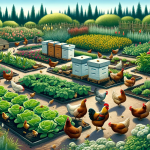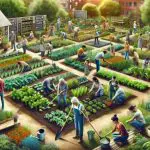
Explore the 5 principles of regenerative agriculture in our latest blog. Dive into sustainable farming practices that nurture our planet. A must-read for eco-conscious enthusiasts!
Regenerative Agriculture 5 Key Takeaways:
The 5 regenerative agriculture principles are:
-
- 1) Minimize soil disturbance,
- 2) Keep the soil covered,
- 3) Maintain living roots in the soil year-round,
- 4) Increase plant and crop diversity,
- 5) Integrate livestock into farming systems. These principles collectively enhance soil health and ecosystem sustainability.
Welcome to our in-depth exploration of the 5 principles of regenerative agriculture!
Join us on a fascinating journey as we uncover how these groundbreaking practices are reshaping farming, nurturing the earth, and paving the way for a more sustainable future.
Whether you’re a farmer, gardener, or simply eco-curious, you’re in for an enlightening read!
5 Principles of Regenerative Agriculture
Regenerative agriculture is revolutionizing our approach to farming and land management.
This sustainable farming method goes beyond traditional practices, focusing on restoring and enhancing the health of the ecosystem.
In this introduction, we’ll explore what regenerative agriculture is, its importance, and how it differs from conventional farming, laying the groundwork for understanding its transformative potential.
What is Regenerative Agriculture?
Regenerative agriculture climate impact represents a significant shift in sustainable farming practices.
Unlike traditional agriculture, it emphasizes not just crop production but also the rejuvenation of entire ecosystems and a proactive stance against climate change.
Core Focus of Regenerative Agriculture
This approach is characterized by its dedication to improving soil health, enhancing biodiversity, and restoring ecological balance.
It’s a method that looks beyond the farm, considering the broader environmental impact.
Scope of the Blog Post
In this comprehensive guide, we will explore the five central principles that define regenerative agriculture.
Our discussion will cover how these principles are implemented, the benefits they bring, and the challenges they pose.
This post is designed to provide valuable insights for a diverse audience, from farmers and gardeners to those interested in a sustainable future.
Understanding Regenerative Agriculture
As a philosophy and approach to land management, regenerative agriculture asks us to think about how all aspects of agriculture are connected through a web—a network of entities who grow, enhance, exchange, distribute, and consume goods and services—instead of a linear supply chain. It’s about farming and ranching in a style that nourishes people and the earth, with specific practices varying from grower to grower and from region to region. NRDC
Principle 1: Minimize Soil Disturbance
In regenerative agriculture, minimizing soil disturbance stands as a critical principle.
This approach challenges the traditional reliance on plowing and tilling, advocating instead for methods that preserve soil structure and health.
This section delves into why reducing soil disturbance is vital, its benefits, and how it fosters a more sustainable agricultural ecosystem.
The Impact of Soil Disturbance
Soil disturbance is a common practice in traditional farming, typically involving plowing and tilling.
However, these methods can disrupt the natural structure and balance of the soil.
Regenerative agriculture aims to reduce this disruption, preserving the soil’s integrity and microbial life.
Implementing Minimal Disturbance
To minimize soil disturbance, regenerative agriculture advocates for practices like no-till farming.
This approach avoids overturning the soil, thereby maintaining the natural soil structure, conserving moisture, and reducing erosion.
The reduction in mechanical interference also helps in building soil organic matter and enhancing its fertility.
Benefits of Reduced Disturbance
By maintaining the soil structure, this principle aids in improving water infiltration and nutrient cycling.
It also fosters a conducive environment for beneficial soil organisms.
Reducing soil disturbance is key to creating a sustainable, productive agricultural system that supports long-term soil health.
Principle 2: Keep the Soil Covered
The second principle of regenerative agriculture, keeping the soil covered, is essential for maintaining a healthy and productive ecosystem.
This section will explore the significance of soil cover in protecting against erosion, conserving moisture, and enhancing soil fertility.
We will discuss various strategies for maintaining soil cover and their long-term benefits for sustainable agriculture.
Essentiality of Soil Cover
Soil cover plays a critical role in regenerative agriculture. Exposed soil is prone to erosion, moisture loss, and temperature extremes, which can be detrimental to soil health.
Keeping the soil covered is, therefore, a key strategy in this sustainable farming approach.
Strategies for Maintaining Soil Cover
To maintain consistent soil cover, techniques such as using cover crops, mulching, and leaving crop residues are employed.
Cover crops, like legumes and grasses, not only protect the soil but also enhance its fertility.
Mulching with organic materials helps in retaining moisture and regulating soil temperature.
Advantages of Continuous Soil Cover
Covering the soil has multiple benefits. It helps in preventing erosion, conserving water, and creating a habitat for beneficial soil organisms.
This practice also contributes to carbon sequestration, a significant factor in combating climate change.
By maintaining a protective cover, the soil remains healthy and fertile, supporting robust plant growth.
Principle 3: Maintain Living Roots in the Soil
The third principle, maintaining living roots in the soil throughout the year, is a cornerstone in regenerative agriculture.
This section focuses on the vital role of living roots in sustaining soil health and biodiversity.
We’ll explore how constant root presence contributes to nutrient cycling, soil structure, and overall ecosystem resilience, underscoring its importance in regenerative farming practices.
Significance of Living Roots
Living roots in the soil year-round are a cornerstone of regenerative agriculture.
These roots are crucial for a healthy soil ecosystem, providing continuous nourishment and support to soil biology.
Approaches to Sustain Living Roots
To ensure that living roots are always present in the soil, regenerative farming employs strategies like diverse crop rotations, intercropping, and incorporating perennials.
These practices ensure that at any given time, there are plants actively growing and contributing to soil health.
Impacts of Continuous Root Presence
The presence of living roots throughout the year has several benefits.
It enhances nutrient cycling, improves soil structure, and aids in the retention of soil moisture.
Living roots also provide a habitat for beneficial soil microbes, fostering a vibrant, life-supporting soil environment.
This continuous biological activity in the soil is essential for sustainable agriculture and long-term productivity of the land.
Principle 4: Increase Diversity
The fourth principle of regenerative agriculture emphasizes the critical importance of increasing diversity in farming systems.
This section will delve into how diverse crop rotations and the incorporation of various plant species contribute to a healthier, more resilient agricultural environment.
We’ll explore the multifaceted benefits of biodiversity, from enhancing soil health to natural pest control, underlining its significance in sustainable farming practices.
Diversity in Regenerative Agriculture
Diversity is a fundamental principle in regenerative agriculture.
This involves growing a variety of plant species, which leads to a more resilient and balanced ecosystem.
Diverse crops support a wide range of above-ground and below-ground biodiversity.
Implementing Crop Diversity
To increase diversity, regenerative farmers use strategies like crop rotation, intercropping, and companion planting.
This includes mixing different types of crops, such as cereals, legumes, and vegetables, in the same area.
Such practices encourage a variety of beneficial insects and microorganisms, enhance soil fertility, and reduce the risk of pest and disease outbreaks.
Benefits of Increased Agricultural Diversity
The benefits of a diverse farming system are manifold.
It leads to healthier soil, reduces the need for chemical inputs, and can improve the overall yield and quality of crops.
Diversity also makes the farming system more resilient to environmental stressors like climate change, pest infestations, and disease outbreaks.
By mimicking natural ecosystems, a diverse agricultural setting creates a self-sustaining environment that is both productive and sustainable.
Principle 5: Integrate Livestock
Integrating livestock into crop systems forms the fifth and vital principle of regenerative agriculture.
In this section, we will explore the symbiotic relationship between livestock and land, and how this integration enhances soil health and ecosystem functionality.
We’ll examine practices like rotational grazing and their impact on nutrient cycling, soil fertility, and biodiversity, highlighting the key role of livestock in a regenerative agricultural system.
Role of Livestock in Regenerative Agriculture
Integrating livestock into crop systems is a pivotal principle of regenerative agriculture.
Livestock play a significant role in enhancing soil health and ecosystem diversity.
Practices of Livestock Integration
Regenerative agriculture employs methods such as rotational or mob grazing, where livestock are moved between pastures to allow for the recovery and regrowth of plants.
This practice mimics natural grazing patterns, which is beneficial for both the soil and the livestock.
The animals contribute to the ecosystem by naturally fertilizing the soil, aiding in seed dispersion, and promoting the growth of diverse plant species.
Benefits of Integrating Livestock
The inclusion of livestock in agricultural systems has several advantages.
It leads to improved nutrient cycling in the soil, better soil structure, and increased biodiversity.
Livestock also contribute to the breakdown of organic matter, enhancing soil fertility and health.
By integrating animals into farming, regenerative agriculture creates a more holistic, self-sustaining ecosystem where plants and animals support each other.
Regenerative Agriculture FAQs
In this FAQ section, we address some of the most common questions surrounding regenerative agriculture.
From understanding its core principles and benefits to addressing potential challenges, this part of the blog aims to provide clear and concise answers.
Whether you’re a seasoned practitioner or new to the concept, these frequently asked questions will enhance your understanding of regenerative agriculture and its role in sustainable farming.
Q: What are the benefits of regenerative agriculture?
- A: Regenerative agriculture offers a multitude of benefits, including enhanced soil health, improved biodiversity, and better water retention. It also contributes significantly to carbon sequestration, helping combat climate change. Additionally, it can lead to healthier crops and, in some cases, improved yields.
Q: Are there disadvantages of regenerative agriculture?
- A: While regenerative agriculture has many advantages, it also comes with challenges. These include the need for a deeper understanding of complex ecosystem interactions, potential initial decrease in yields during the transition phase, and a requirement for more hands-on management compared to conventional practices.
Q: How does regenerative farming work?
- A: Regenerative farming works by applying principles that mimic natural ecosystems. This includes minimizing soil disturbance, maintaining soil cover, ensuring living roots in the soil year-round, increasing plant and crop diversity, and integrating livestock. These practices work together to rejuvenate soil health and create a sustainable farming system.
Q: What are the four principles of regenerative agriculture, often referred to as the ‘KISS’ (keep it simple, stupid) principle?
- A: The ‘KISS’ approach in regenerative agriculture typically refers to keeping practices simple and nature-based. This involves minimizing soil disturbance, maintaining soil cover, promoting biodiversity, and integrating natural processes like animal grazing and natural pest control.
Q: What is the regenerative agriculture definition?
- A: Regenerative agriculture is defined as a system of farming principles and practices that seeks to rehabilitate and enhance the entire ecosystem of the farm by placing a heavy emphasis on soil health, water management, and biodiversity.
Q: How is regenerative gardening applied?
- A: Regenerative gardening involves similar principles as regenerative agriculture but on a smaller scale. It includes practices like using compost, minimizing soil disturbance, planting diverse species, using natural pest control methods, and creating habitats for beneficial insects and wildlife.
Q: What is regenerative agriculture certification?
- A: Regenerative agriculture certification is a formal recognition given to farms that adhere to specific regenerative farming practices. This certification often involves maintaining soil health, using renewable resources, and enhancing ecosystem services.
Q: What role does regenerative agriculture play in climate change?
- A: Regenerative agriculture plays a significant role in mitigating climate change by sequestering carbon in the soil. Healthy, living soils can capture and store carbon from the atmosphere, helping to reduce overall greenhouse gas levels.
Q: Can you explain regenerative animal agriculture?
- A: Regenerative animal agriculture refers to livestock management practices that contribute to ecosystem regeneration. This includes rotational grazing, holistic land management, and practices that enhance soil health and biodiversity.
Q: What are the key practices in regenerative vegetable farming?
- A: Key practices in regenerative vegetable farming include crop rotation, cover cropping, composting, minimal soil disturbance, and fostering a biodiverse environment conducive to natural pest control and soil health.
Conclusion
Regenerative Agriculture: A Path Forward
Regenerative agriculture stands as a beacon of hope in our quest for sustainable and environmentally friendly farming.
It represents a paradigm shift from traditional agricultural practices, focusing on the long-term health of the ecosystem rather than short-term gains.
This approach is not only about growing crops but nurturing the land to yield benefits for future generations.
As we conclude our exploration of its five core principles, let’s reflect on the broader implications and how each of us can contribute to this transformative movement.
Sustainable Solutions for a Better Tomorrow
Rebuilding Soil Health
At the heart of regenerative agriculture lies the commitment to rebuild and maintain the principles of soil health.
Healthy soils are the foundation for a robust ecosystem, capable of sustaining high-quality crop production while combating climate change through carbon sequestration.
Promoting Biodiversity and Ecosystem Resilience
Regenerative practices enhance biodiversity both above and below the soil.
This biodiversity is essential for creating resilient agricultural systems that can withstand environmental stresses and contribute to a balanced ecosystem.
The Role of Regenerative Practices in Climate Change Mitigation
Regenerative agriculture has a critical role to play in mitigating climate change.
By capturing carbon in the soil, it helps in reducing greenhouse gases, positioning itself as a key solution in global climate change strategies.
Every Step Counts
Individual Contributions to Regenerative Practices
Even small-scale gardeners and consumers can contribute to regenerative practices.
Supporting local regenerative farms, practicing sustainable gardening techniques, and being mindful of the environmental impact of our food choices are ways everyone can contribute.
The Future of Farming
As we look to the future, regenerative agriculture offers a roadmap for sustainable farming.
It aligns regenerative agricultural practices with ecological principles, ensuring that we can continue to produce food without depleting our natural resources.
Regenerative agriculture is more than just a set of practices.
It’s a philosophy that respects and works with nature. Its principles provide a guide for sustainable living and farming, paving the way for a healthier planet and a sustainable future.
For more information and resources on regenerative agriculture, consider exploring educational platforms, engaging with local farming communities, and staying updated with agricultural research. Join the regenerative agriculture revolution!
Read more: Permaculture vs Regenerative Agriculture – Sustainably Forward
Permaculture Gardening: Best Tips for Beginners
Why is Regenerative Agriculture Important? – Sustainably Forward






